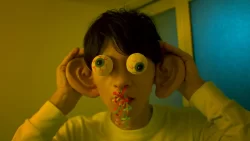Dreams, reality, folklore, and everything in between: “It’s a Mad Mad Multiverse” encompasses it all. The collection of shorts traverses unique universes but the themes are universal, covering guilt, trauma, grief, longing, nostalgia, and friendship. Here’s a look at the seven shorts.
SRIKANDI
According to Indonesian mythology, Srikandi was a talented archer who wasn’t allowed to be a warrior because of her gender. Often associated with women’s rights in Indonesia, she’s the inspiration behind Andrea Nirmala Widjajanto’s film of the same name. The main character, 17-year-old Anjani (Rai Putriansyah), is a modern version of the heroine, who aspires to follow in her late father’s footsteps of becoming a puppeteer, despite not being allowed. CineVue’s Patricia Kusumaningtyas recently talked to the director about bringing her culture to the forefront of the film.
POACHERS
In 2019, Tiffany Lin read an article that would inspire “Poachers.” It was about three men who were arrested on the California coast with over $600,000 of poached succulents they planned to sell. “I’m interested in finding unconventional perspectives and wanted to tell this story from the point of view of the least likely people you’d think would commit such a crime,” Lin says. So, she wrote about two Asian American teenage girls who take advantage of this business opportunity, as a nuanced exploration of greed pushing people to their limit and its effect on the environment and their relationships along the way.
Amidst the calming scenery of the West Coast, the crime thriller raises the stakes of their hustle and builds suspense, eventually leading the protagonists to another, more heinous crime. The girls (Laurel Wong and Olivia Cordell) are wracked with guilt – at least, until receiving their payment. But before they can put the events behind them, their buyer (Christine Liao) turns the seemingly innocent succulent into something more eerie, ominous – and omniscient: Known as immortal plants in Chinese, “They never forget what they’ve seen.” Triggering one girl’s remorse, she returns back to the scene of the crime to find closure – on the events and perhaps, her friendship.
THANK YOU, COME AGAIN
An Indian American man stares at a racial slur spray painted on a convenience store window. There’s no sound, but there’s none required to invoke a chilling familiarity. Back in the store, it takes a moment to register, but the film turns to the man’s subconscious – the anti-Asian words on the window provoking a painful childhood memory: his father’s (Asit Vyas) arrest and death during an attempted border crossing.
A former undocumented South Asian immigrant living post-9/11, director, writer and lead actor Nirav Bhakta employs a unique visual style to convey the polarity of being perceived as a caricature or threat. While the convenience store itself represents the confinement of the American dream, “Each aisle represents a different stage of grief,” he explains. The short is choreographed accordingly: As his father and younger self (Rohan Singh) hide among the shelves, the man watches behind the counter; the traumatic events play out in front of him like scenes from a psychological thriller. He’s part of the memory, but not quite. “Thank You, Come Again” hits on a difficult topic, but for Bhakta, this is his way of humanizing and “bringing the audience into the uncomfortable emotional weight immigrants often quietly carry with them.”
REINCIDENCE (リインシデンス)
Every time Yoko (Yuki Yamamoto) falls asleep, she wakes up in a different world. One day, she’s a flight attendant, an antiques cafe employee, and then a mother returning home after a trip. Though she doesn’t notice the changes at first, she recognizes the same man (Kosuke Fujita). While their worlds shift, their paths continue to cross, he explains.
With COVID-19 upending a world that he thought would last forever, director Tomomi Muraguchi created “Reincidence” “from the idea that tomorrow’s world will be completely different and may not be a fantasy.” Through conversations and dreamy backdrops, he raises questions about what it means to be bound by the threads of destiny across a multiverse blurring reality and dream. Instead of bringing his two characters together in a strictly romantic sense, the two are close friends, enemies, but mostly just strangers in these worlds. Perhaps, this suggests that fate is merely what we make of it. As Muraguchi closes the film, he provides “a message that we must live happily even in such a [changing] world.”
TIL IT BLOOMS (开到荼蘼)
At his father’s funeral, Bo (Tom Choi) begins sprouting flowers all over his body before he’s set to give a eulogy. He tries to hide them, grappling with his complicated relationship with his father. But his veins become darker, he coughs up blood and winces in pain, and new vines erupt and choke him, implying that his buried emotions are only eating away at him. Eventually, he’s nothing but a human flowerbed, hiding in the bathroom.
Bo does make it out to deliver his speech, but it’s not before breaking down in a dramatic yet comedic fashion. Through his transformation, director Wendy Xu takes a traditional symbol of sympathy and reimagines them as a physical manifestation of grief for an emotionally-suppressed, middle-aged East Asian father. It’s more fantasy than body horror, but Xu attempts to address some of the stigma against displaying vulnerability among men – and perhaps, even in some traditional Asian cultures at large. As he cries, Bo sheds his flowers, like a caterpillar shedding its chrysalis. It’s uncomfortable for the attendees at first, but as he becomes recognizable again, there’s catharsis and relief.

THE LIMIT MODULAR BATH FOR TWO
Part of the Hulu drama series “THE LIMIT,” “Modular Bath for Two” explores how confined space and difficult circumstances can reveal a person’s true nature. In Masaya Yoshida’s film, entertainer Shimada (Yoshihiko Hosoda) finds himself in a young woman’s bathroom after an implied night together. There, he encounters burglar Kuwamoto (Udai Iwasaki), hiding in the tub. To avoid a scandal after his recent marriage, Shimada allows Kuwamoto to leave without consequence – that is, until he’s recognized.
As the tables turn, the burglar realizes he holds leverage and becomes bold, asking for autographs, attempting blackmail, and even lecturing the comedian for his behavior. Assuming what we know about Shimada, Kuwamoto’s behavior is comical, yet exasperating. But while the film is framed as a comedy, it slowly uncovers a dark truth about the comedian. With the tables turned once more, the audience becomes aware of the subtle, clever references that were there all along, hinting that he is not really who he says he is.

THE 17 CLUB
In “The 17 Club,” we meet aspiring teen writer Nanairo (Fuka Kumazawa), a character in a story within a story. The title of the film actually refers to her latest piece of work, a self-insert where she acquires the power to reverse time by one second. After receiving feedback from her friend Rinne (Fuka Oishi), Nanairo takes the comments personally, but it gives her the push to find closure for her story. Paralleling this new resolution, Rinne also reveals that their time together in real life will come to an end too, as she leaves Japan.
At its core, Shota Mori’s film is about friendship – but what really stands out is its visual style. Instead of making use of a traditionally widescreen format, the short confines itself to vertical video. With the frame split into bright panels, human characters interacting with illustrated elements, and speech bubbles with a cheery English dub reading along, it resembles a manga, literally lifted off the page. Combined with several callbacks between Nanairo’s work and reality, these elements come together to create a layered coming-of-age narrative that touches on growing up, facing rejection, and in the process, finding your voice.
“The 17 Club” can be watched in full on YouTube.
The “It’s a Mad Mad Multiverse” shorts block screened at the 45th Asian American International Film Festival.

